Malaysia Airlines MH370: The persistence of conspiracy theories
- Published
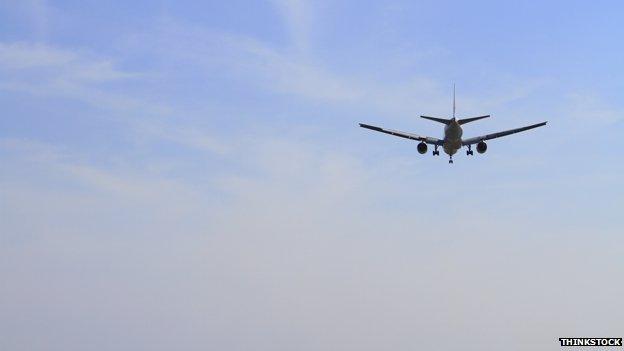
A Boeing 777 - the same type of plane as MH370
Six months after the disappearance of Malaysia Airlines flight 370 it is still the subject of a slew of explanations. Why has this tragedy prompted such a wave of conspiracy theories?
Sudden, dramatic events often provoke conspiracy theories - particularly where the official version is disbelieved. Think JFK, Princess Diana, 9/11.
But in the case of MH370 there is not even an official version. Nobody knows what happened to MH370. It's a modern mystery.
"It is very rare to be able to proffer no convincing answer for an event," says Times columnist David Aaronovitch, whose book Voodoo Histories tackles conspiracy theories.
Then there's the context. After the revelations by Edward Snowden about the extent of global surveillance by the US National Security Agency, it seems somehow hard for laymen to believe that an airliner can just disappear. Everyone was thinking about surveillance but no-one could find the plane, says Jovan Byford, author of Conspiracy Theories: A Critical Introduction. "The incongruity of those two things has led people to think something was going on."
At the start, nearly everyone had a theory.
And because there was very little solid evidence, it was hard to debunk completely any single explanation.
But then information about the pings sent to a satellite from the plane showed it had ended up somewhere west of Australia. The theories began to fizzle out, only to intensify again in July when Malaysia Airlines MH17 crashed in Ukraine.
Some of those attempts to explain the mystery, reveal something of the nature of conspiracy theories.
Shot down by US/Thailand
Author Nigel Cawthorne believes the plane was shot down by US/Thai fighters during a military exercise, external.
"There's always a military exercise," says Aaronovitch. So many are going on at any one time that it's hardly significant.
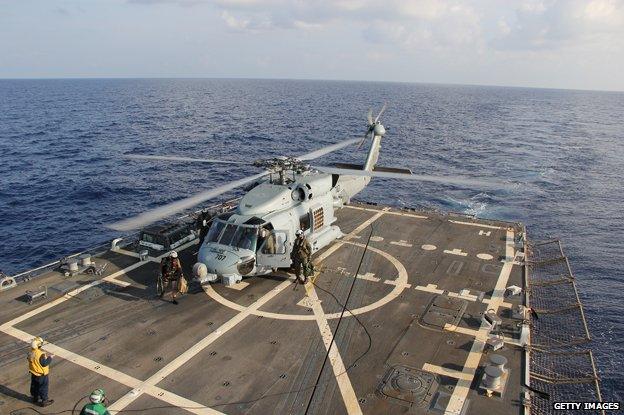
US Sea Hawk helicopter aboard USS Pinckney during the search for MH370 in the Gulf of Thailand
On the other hand, civilian planes do sometimes get shot down. Korean Air flight 007 was shot down by the Soviet Union in 1983, the US Navy downed an Iranian airliner in 1988, and MH17 appears to have been shot down by mistake. In all cases, the crashes were reported quickly.
It might seem hard to believe that the US and Thai governments would either want or be able to hush up the shooting down of a Boeing 777 for six months. But part of the conspiracy theorist's art is to shout cover-up, says Sylvia Wrigley, author of Why Planes Crash. "Once the theory includes government cover-up it's incredibly hard to prove this thing isn't true."
MH370 and MH17 were the same plane
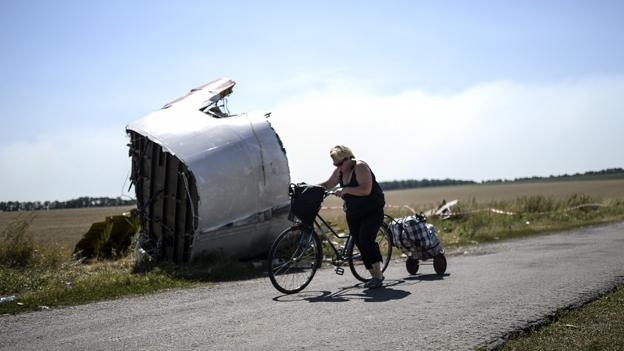
Wreckage from Air Malaysia flight MH17, which was shot down over Ukraine in July
Forums have seen discussions of claims that the plane purported to be MH17 at the crash site in Ukraine was actually MH370. Both aircraft were the same model but MH17 was a 1997 version as opposed to MH370, which Malaysia Airlines took ownership of in May 2002. Proponents of this conspiracy theory claim photographs from the crash scene show the plane was the newer version.
"The MH17 plane had an extra window next to the second right-side door, which MH370 did not - and neither did the wreckage" at the MH17 crash site, one account reads. Much of the theory centres on where the Malaysia flag appeared in the plane's livery.
According to a pro-Russian rebel leader, external, the bodies had been dead days before the plane took off. In this theory, the passports were supposedly pristine and had been planted on the dead bodies.
But other plane bloggers have rubbished this theory of the windows and flag. And then there's the detail of the theory. Could anybody steal an airliner with 239 people on board and keep it hidden for six months? Is it possible to believe it was loaded with corpses and substituted for a scheduled Malaysia Airlines flight from Amsterdam to Kuala Lumpur?
The coincidence of two Malaysia planes being the subject of a tragedy is exactly that - a coincidence, the experts contend. "The whole idea of coincidence is dismissed [by conspiracy theorists] as a very naive proposition," says Byford. Yet there is usually a statistical explanation behind coincidences. Malaysia Airlines flew the fifth most flights of any airline over Ukraine in the week before the shooting down of MH17.
In Pakistan for terrorism
Retired US Lt Gen Thomas McInerney argued in the wake of the plane disappearing that it was flown to Taliban-controlled Pakistan. It would be used against the US later. "If the Pakistani government doesn't talk soon they're going to be complicit in this," McInerney told Fox News, external, where he works as a military analyst. The plane could be used to carry weapons of mass destruction to hit an aircraft carrier or attack Israel, he said.

Is the plane in the hands of Taliban fighters?
McInerney's theory was based on the idea that Pakistan would have been consistent with the final ping from the plane to a satellite. He argued that the US government knew far more than it was letting on and did not want to embarrass allies in the region. Rupert Murdoch was one of those who had also speculated, external that the plane was in Pakistan.
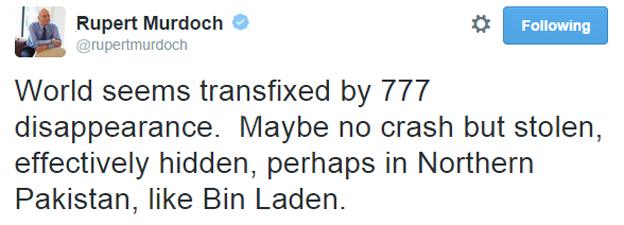
But work done later by British firm Inmarsat ruled out the Pakistan theory, external. At first, using the plane's satellite pings, Inmarsat calculated the plane had either headed on an arc northwards over the Asian landmass or south towards the empty Indian Ocean. But within three weeks of the disappearance it had ruled out the northern arc, concluding the plane was somewhere in the southern corridor.
The latest search area is 60,000sq km (23,000 sq miles) of the southern Indian Ocean to the west of Australia.
Chinese submarine
British barrister Michael Shrimpton claimed that a Chinese submarine used a missile to shoot the airliner down south of Vietnam. There was a "person of interest" on MH370 whom the Chinese wanted to assassinate, although Shrimpton said he didn't know who it was.
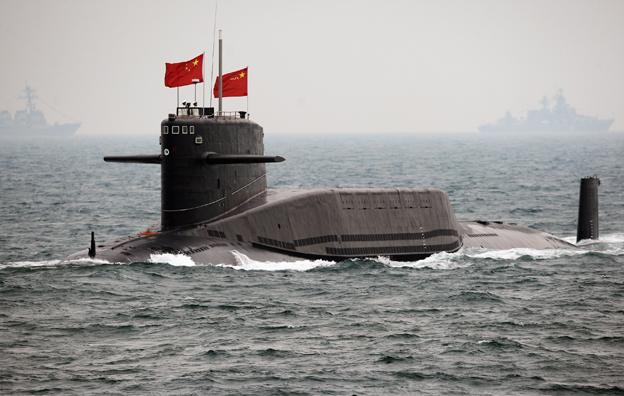
But if the aeroplane had broken up at 30,000ft there would have been debris in the sea, says Wrigley. And the south of Vietnam was part of the initial search before it was switched.
Freescale staff intercepted
On MH370 were 20 employees of US technology company Freescale Semiconductor. It makes powerful microchips for different sectors, including the defence industry. Twelve employees were from Malaysia and eight from China. It led to speculation that they held important industrial secrets. In one conspiracy theory, the US government feared they would fall into the hands of the Chinese authorities. As a result, the plane was hijacked and taken to the US base on Diego Garcia.

In another variation of the theory, it was the Chinese who took control of the flight to interrogate the Freescale staff to find out the scope of US surveillance. There was yet another theory - that Iran put passengers on stolen passports onboard in order to get control of Freescale's technical knowhow.
Freescale says the employees onboard were technical staff travelling to the company's chip facilities for a review. A patent frequently cited by the conspiracy theorists does exist, external. But rather than being military in nature, it covers a system for optimising the number of circuits on a piece of semi-conductor material. And none of the four people mentioned as being the patent holder were on the plane.
Cyber hijack
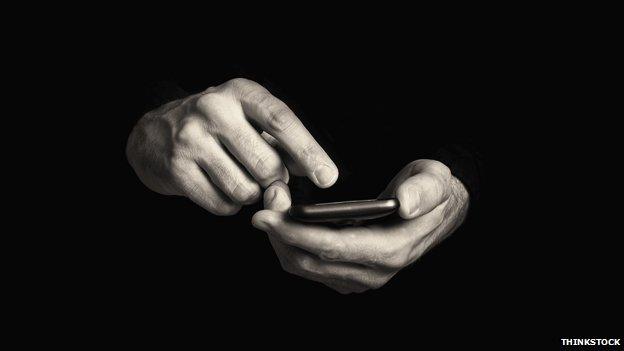
At a conference last year, a security consultant called Hugo Teso hacked into virtual planes that were being flown on autopilot. He was using an android phone and an app he'd developed. The Independent called it "terrifying", external.
After MH370 went missing, anti-terror expert Dr Sally Leivesley suggested the plane could have been taken over, external by a mobile phone or USB stick.
So how vulnerable are planes to hacking? The Federal Aviation Administration said that Teso's hack would not work, external on certified flight hardware.
Wrigley says that the pilot can always turn off autopilot if the plane starts making unexpected course changes. If someone did hack into the aircraft and take over the plane using the flight management computer, they would have had no means of keeping that control. "If an aircraft flight management system could be hacked by remote control, it would cause a lot of confusion on the flight deck, but I can't imagine that any pilot would just sit back and watch while the aircraft changed course." In that event surely they would find some way of communicating the problem.
Some theorists, says Aaronovitch, see money to be made from books and speaking tours. But whatever their motive governments can occasionally find them useful, says Byford.
Conspiracy theorists cannot bear life's messy reality, says Aaronovitch. "It's the fear of chaos." It's easier to believe in huge cover-ups than to accept no-one really knows what happened to MH370. Most people in the developed world fly and it's alarming to admit you don't know what happened to the plane.
The problem isn't speculating. "But speculating drawing on the established cult of conspiracy theorising is wrong. It's misleading and it locates the problem in the wrong place," says Byford.
In the case of MH370, there's no need to theorise, argues David Learmount, safety editor at Flight Global. "We know what happened. There's only one thing it can be - a deliberate act by someone on board, probably the captain."
Wrigley thinks this is too simple. The final ping from the plane is consistent with the idea that it ran out of fuel. But it seems implausible that a pilot wishing to kill himself and everyone on board would have chosen to allow the plane to fly until it ran out of fuel, Wrigley argues. "In my opinion someone diverted the aircraft and then something else went wrong - maybe a terrorist attack or kidnap."

Relatives await news of MH370 in Beijing
Aaronovitch doubts that MH370 will still generate masses of conspiracy theories in several decades' time. It is not an era-defining event like the JFK assassination. "You saw that shooting on television. JFK was all a generation talked about for a while." The feverish and conspiratorial atmosphere of the Cold War was part of it.
But for the moment, the case of MH370 will continue to be fertile ground for conspiracy theorists - unless the wreckage is found and the mystery solved.
Subscribe to the BBC News Magazine's email newsletter to get articles sent to your inbox.